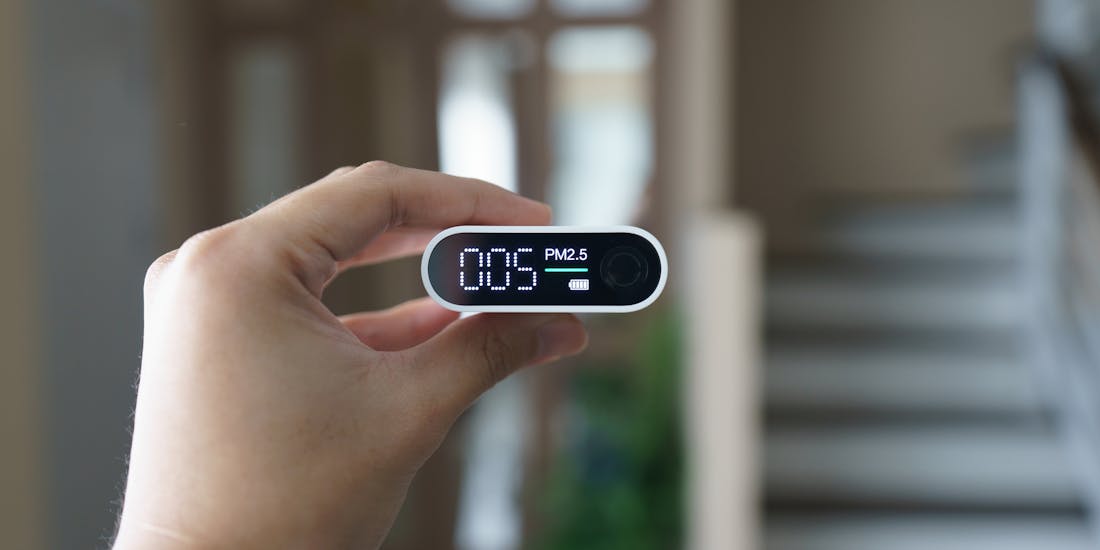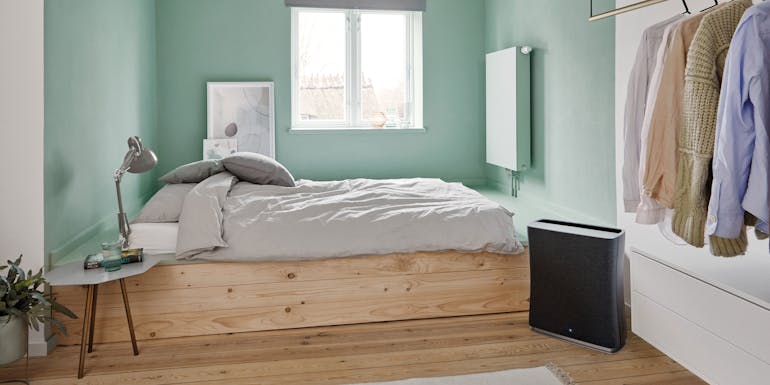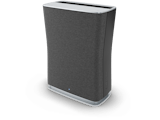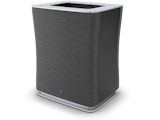
Nadine Walder, 15 May 2024
Purify the air
Reduce fine dust in your home: Tips & tricks
Particulate matter is not only a problem outdoors, but also within our own four walls. Fine dust pollution indoors is often much higher than outside and can have a negative impact on our well-being and health. Fine dust accumulates indoors, is more concentrated and cannot escape. We explain what sources of particulate matter in your home are, why they are not good for us and how you can reduce particulate matter pollution in your room air with simple tips and tricks.
Read on to find out:
- What is particulate matter?
- Sources of particulate matter in the home
- Tips and tricks for reducing fine dust indoors
- Devices that help reduce fine dust pollution
What is particulate matter?
Particulate matter is the smallest particles suspended in the air. They are invisible to the naked eye as they are tiny – the best known have a diameter of less than 2.5 (PM2.5 particles) or 10 (PM10 particles) thousandths of a millimeter. By comparison, an ordinary sheet of paper is 0.1 mm thick. The danger of these particles lies precisely in their small diameter and because they are invisible to the human eye. The small particles can penetrate deep into the respiratory tract, right into the lungs. As a result, they can cause various health problems such as bronchitis and asthma.
In our blog post "Particulate matter: everything you need to know about it", we explain in detail what particulate matter is, the dangers of excessive particulate matter pollution and draw an international comparison of air pollution worldwide.
Sources of particulate matter in the home
Fine dust can enter your indoor air from outdoors, but it can also be generated directly indoors. Fine dust enters our homes from outside, for example through leaky, poorly insulated or open windows. This is a major problem, especially on busy roads, as particulate matter is produced by car exhausts, construction work or smoke from combustion processes, for example. We also bring fine dust indoors ourselves, for example through our clothes, shoes and hair.
Saharan dust blows into Europe, especially in spring and autumn. It causes an additional increase in fine dust pollution and can also enter indoor spaces. Although this source of fine dust is less dangerous than the particles from combustion processes, it can still be harmful to allergy sufferers.
The indoor sources of particulate matter are manifold. One of the most common sources is combustion processes. This includes, for example, cooking and frying without an extractor hood. Tiny droplets of fat are released, which are dispersed in the air and can settle as fine dust. Lighting candles or using a fireplace can also produce particulate matter such as soot particles that settle in the air. The burning of tobacco products such as cigarettes also releases particulate matter. The surface abrasion of textile fabrics and carpets can also generate particulate matter, as can the operation of electronic devices such as photocopiers or toasters.
Tips & tricks for reducing fine dust in the home in in the house
Fortunately, there are a few simple tips and tricks you can use to reduce the fine dust pollution in your indoor spaces. If you regularly air the rooms, vacuum, damp-mop the floor and thoroughly clean your furniture and other objects, you can already reduce fine dust pollution. It also makes sense to change your clothes after being outside. The following points additionally ensure better indoor air:
- Do not smoke indoors
- Avoid open fires and candles
- Avoid incense sticks, scented candles or scented sprays
- Always use an extractor hood when cooking and frying – clean it regularly and replace the filters
- Use cosmetic products such as hairspray or nail varnish sparingly and in well-ventilated rooms
- Wash newly purchased clothes and textiles immediately after purchase
- Wash your clothes and hair regularly
- Make sure the humidity is between 40 % and 60 % – as a result, the fine dust particles are moistened and sink to the floor more quickly.
Devices that help reduce fine dust pollution
In addition to these simple measures, there are devices that you can use specifically to reduce fine dust pollution:
- Vacuum cleaner with HEPA filter or water hoover: One method of eliminating dust is, of course, vacuum cleaners. Here you should definitely pay attention to the quality of the air filters. Follow the manufacturer's instructions. Alternatively, you can use a water hoover. With these devices, the dust and other particles are bound directly in the water and do not get back into the ambient air.
- Air measuring devices: To keep an eye on particulate pollution at all times, there are special measuring devices that measure particulate pollution. There are simpler devices that only measure particulate matter, but there are also devices that measure CO2 and TVOC levels, among other things. TVOC is a measurement of the total concentration of all volatile organic compounds (VOC) in the air.
- Air purifier: A very useful measure to filter fine dust particles from the air is to invest in a high-quality air purifier. An air purifier ensures clean air all year round by filtering bacteria, viruses, pollen, dust and other particles from the air. When buying an air purifier, you should always check the quality of the filter and the manufacturer's specifications. Air purifiers with HEPA and activated carbon filters are among the most powerful air purifiers, as they can filter even the smallest particles and bad odours. For optimum performance, you need to replace the filter regularly. With Stadler Form air purifiers, the air quality is measured using various sensors (e.g. gas and particle sensor PM2.5). In our Roger family, the quality of the air is visualised via an integrated air quality display. Roger and Roger big can also be controlled via an app so that you can keep an eye on the air quality in your home at all times.
By applying a few simple tips and using suitable appliances, you can do a lot to reduce the fine dust pollution in your home and thus ensure a healthier environment.
Would you like to find out more about air purification? On our information page you will find useful tips and tricks as well as everything you need to know about indoor air purification.
If you have questions related to indoor room climate, please get in touch with us. Or subscribe to our newsletter to regularly get informed about current topics regarding indoor climate, experience reports or Stadler Form insights.







